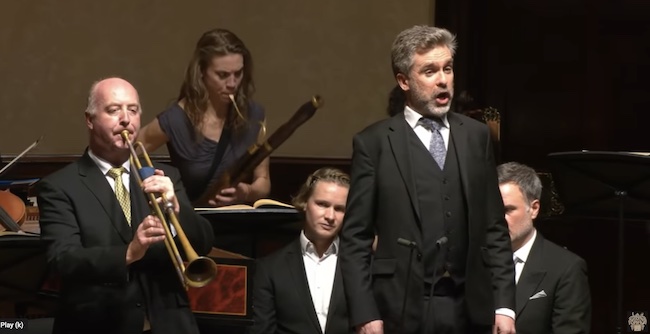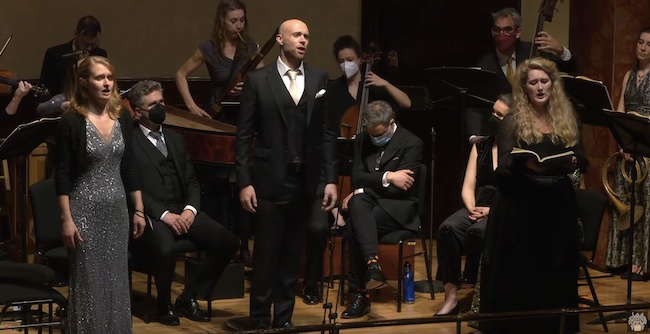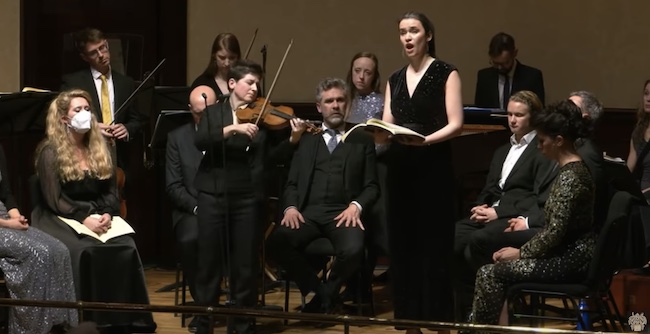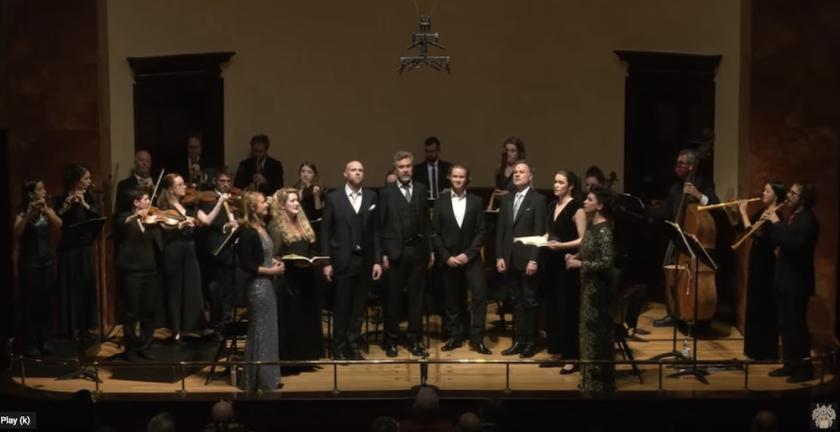It had been a tense week, explained Jonathan Sells, the artistic director and bass-baritone of Solomon’s Knot, from the stage of the Wigmore Hall: unsure if the concert would go ahead, unsure who exactly would be able to perform, unsure if there would be anyone in the audience.
In the event it did go ahead, there was an audience present (although I was watching the livestream) and the hastily revised cast cramming the stage gave a joyful and uplifting account of Bach’s Christmas Oratorio that was a triumph in the circumstances.
Solomon’s Knot’s credo is “to blow the dust off early music” and “never to lose the joy of performing”. They all certainly looked happy to be there, even if the future for performing musicians is suddenly very uncertain. The band are period instrument specialists without a conductor and the singers perform from memory – although there is no complaint that the late stand-ins Hilary Cronin and Helen Charlston carried music. The eight voices and 21 instruments captured the festive tone of the music, ranging from the grandeur of the opening to the interior monologue of cantata IV, with a spry and precise energy. The programme was four of the six cantatas that make up the Christmas Oratorio. The glorious opening featured crisp vocal consonants pushed along by the punchy timpani (Rosemary Toll), and Neil Brough’s natural trumpet solo (pictured above) was thrillingly virtuosic. The pastoral second cantata featured an athletic aria by tenor Ruairi Bowen, but it was the recitatives that impressed throughout: Bowen and Alex Ashworth in particular offering gripping and committed storytelling. Kate Symonds-Joy’s aria "Schlafe mein Liebster, genieße der Ruh" was sweet-toned and complemented by elegantly shaped oboe lines.
The programme was four of the six cantatas that make up the Christmas Oratorio. The glorious opening featured crisp vocal consonants pushed along by the punchy timpani (Rosemary Toll), and Neil Brough’s natural trumpet solo (pictured above) was thrillingly virtuosic. The pastoral second cantata featured an athletic aria by tenor Ruairi Bowen, but it was the recitatives that impressed throughout: Bowen and Alex Ashworth in particular offering gripping and committed storytelling. Kate Symonds-Joy’s aria "Schlafe mein Liebster, genieße der Ruh" was sweet-toned and complemented by elegantly shaped oboe lines.
I also enjoyed throughout the evening how the group found different ways of articulating the chorales, transformed from the harmony exercises that dominated my degree studies to living musical statements, such as the elastic, triple-time “Wir singen dir in deinem Heer” that ended cantata II. Cantata III – indeed the whole show – was held together by Jonathan Sells (pictured above, with Clare Lloyd-Griffiths and Hilary Cronin), who lives every moment on stage, setting tempos and beginning choruses with no more than an inclination of his head. His is an authoritative stage presence but not a vainglorious one. He projected a relaxed enjoyment that belied his supremely stressful week. Alto Helen Charlston (pictured below), another last minute call-up, was quite the substitute, her silvery sound and sensitive dynamic range accompanied like a second voice by violinist (and leader) Kinga Ujszászi.
Cantata III – indeed the whole show – was held together by Jonathan Sells (pictured above, with Clare Lloyd-Griffiths and Hilary Cronin), who lives every moment on stage, setting tempos and beginning choruses with no more than an inclination of his head. His is an authoritative stage presence but not a vainglorious one. He projected a relaxed enjoyment that belied his supremely stressful week. Alto Helen Charlston (pictured below), another last minute call-up, was quite the substitute, her silvery sound and sensitive dynamic range accompanied like a second voice by violinist (and leader) Kinga Ujszászi. Cantata IV gave centre-stage to the natural horns (Anneke Scott and Anna Drysdale), giving their distinctive colouring to the entire piece. The highlight was the wonderful section where the sopranos overlay the chorale onto a recitative by Sells, a wonderful combination of two strands of music that exemplifies in miniature Bach’s unassailable genius.
Cantata IV gave centre-stage to the natural horns (Anneke Scott and Anna Drysdale), giving their distinctive colouring to the entire piece. The highlight was the wonderful section where the sopranos overlay the chorale onto a recitative by Sells, a wonderful combination of two strands of music that exemplifies in miniature Bach’s unassailable genius.
The livestream showed the leaps forward Wigmore Hall has taken since its early experiments. There are now multiple cameras, with well-paced editing between them, and an informative presentation by Ian Skelly. The livestreams are offered for free, which represents very good value especially in this case.














Add comment